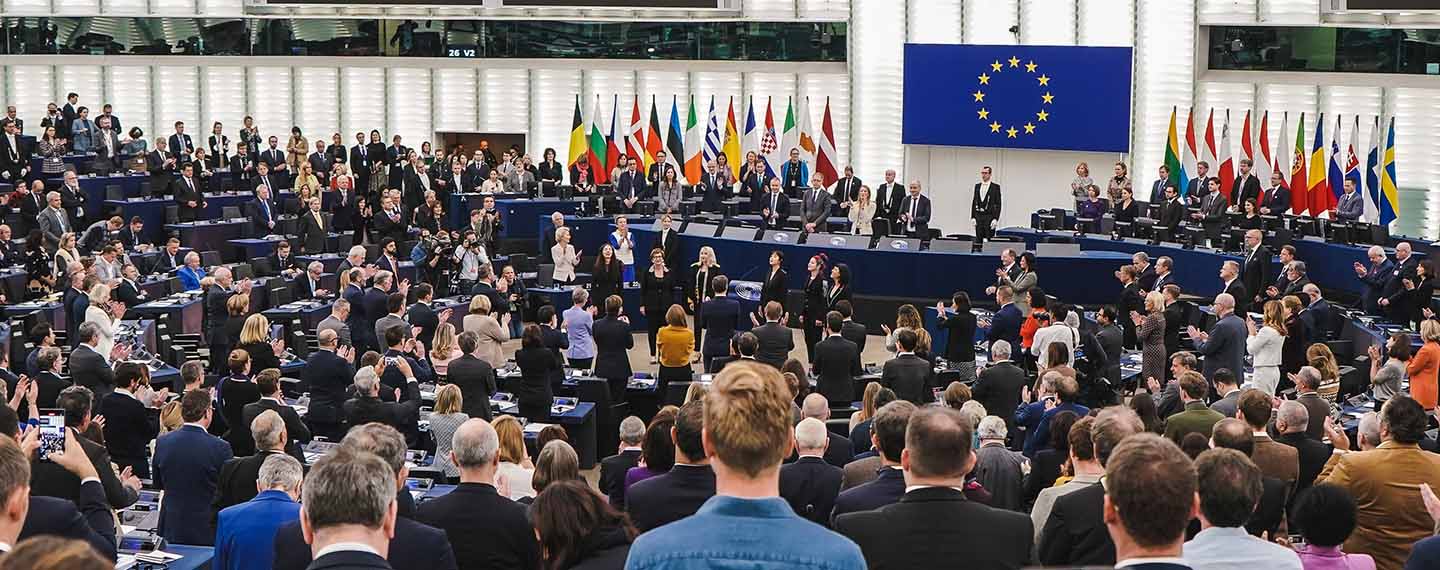Theme
After 70 years of integration, the EU continues to evolve through processes that largely marginalise citizens. If the post-Lisbon EU has constitutionally embraced a model of democracy under which citizen participation is an additional source of legitimacy for the Union in its day-to-day decision-making, this has not translated into a major transformation in how citizens participate in the Union’s democratic life (beyond elections). The question of how the Union would look like if it had put citizens at its centre, not at the margins, remains not only unanswered but also unimagined.
Summary
For more than two decades there has been a widespread intensifying belief that, without greater involvement of citizens, the EU is condemned to fail. In light of the shortcomings in EU representative democracy, the last decade has witnessed new commitments in favour of participatory democracy. While there are embryonic forms of citizen participation at virtually every stage of the policy cycle, ranging from the right to petition to the European Parliament and the right to access to documents, to the right to complain to the EU Ombudsman and European Citizens’ Initiatives, they remain unknown, scattered and underused by the average European citizen. In these circumstances, citizen participation cannot make up for the EU’s citizens inability to signify their desire for change in the EU political agenda. This is immediately due to a participatory practice characterised by unequal access to, limited representativeness of and ultimately disparate influence of participants in the EU’s decision-making, but is also a function of a broader set of structural features characterising EU democracy. The participatory instruments that have been created are detached from citizens’ political opinion-formation and will-formation –which solely occur at the domestic level–, and ultimately contribute very little to the legitimacy of the EU’s governance. Seen from this perspective, the possibility of embedding a representative deliberative process in the EU’s institutional architecture would offer an opportunity to compensate for the current shortcomings of EU participatory democracy, notably its limited accessibility, responsiveness and effectiveness. No other available democratic participatory innovation can bring citizens into the heart of the EU’s decision making in such an inclusive, representative and informed manner, and constructively contribute to provide citizens with a political voice in the space between elections. Therefore, the EU should seriously consider institutionalising some forms of deliberative processes into its institutional architecture, by connecting them to the existing participatory channels. While the creation of representative deliberative processes may potentially transform the architecture of representative democracy also in the Union, their institutionalisation does not automatically alter the EU’s institutional framework. It is proposed to establish a permanent, deliberative body made of randomly selected citizens, capable of convening one or more on-demand thematic citizen assemblies on a yearly basis. This would be activated in full sync with existing participatory mechanisms in order to enhance their own uptake, effectiveness and ultimate legitimacy, as well as political demand by the EU’s main institutions. This uniquely integrated participatory and deliberative system could enable the EU democratic model to develop and thrive.
Analysis
1. The EU framework for citizen participation
After being a non-issue for several decades, the role that citizens –and more broadly civil society– should play within the Union became central to the EU’s political discourse back in the late 1990s. It was in the 2000 Commission White Paper on European Governance that citizen participation was recognised as one of the pillars of good governance, well beyond social policies. Due to its focus on participation of organised interests, the White Paper perceived participation in instrumental ways as a means of improving the efficiency and effectiveness of European policymaking, thus neglecting unorganised citizens.
Amidst the vicissitudes of the failed Constitutional Treaty –which first tried to define the democratic nature of the EU’s legal order, in particular its own specific democratic model–, the Lisbon Treaty eventually recognised that the Union derives its democratic legitimacy not only from representative democracy –which remains its founding democratic principle– but also from participatory democracy. Under the former, citizens take part in the political process through their elective representatives –Parliament and the governments gathering in the Council of the EU (hereinafter ‘the Council’)–, whereas under the latter, citizens participate directly via a multitude of channels of participation. As a result, participation carries an autonomous, non-instrumental meaning: to allow citizens to take part in –and possibly control– the process of governance to which they are subject. In normative theory, participatory democracy entails the multiplication of opportunities for citizens’ participation beyond elections.
2. The EU’s participatory toolbox
The EU today provides a wide array of participatory opportunities to its citizens to engage with –and potentially influence– EU decision-making. These mechanisms range from the oldest instrument of participatory democracy, the right to petition, to the most recent one, the European Citizens’ Initiatives (ECI) –the first transnational participatory democracy instrument allowing at least seven EU citizens from seven different Member States to suggest new policy initiatives in any field where the EU has power to propose legislation (such as the environment, agriculture, energy, transport and trade) after collecting one million signatures–. These also include:
- Requests for access to documents of EU institutions.
- Public consultations by the Commission.
- Complaints to the European Ombudsman.
- Complaints to the Commission.
What these participatory channels have in common is that –regardless of their immediate aims and scattered origin– they enable citizens to play a role ‘in the Union’s democratic life’ and to do so beyond the electoral moment. By opening the Union’s doors, they give citizens a chance to ‘publicly exchange their views in all areas of Union action’. As such, by exercising an informational, agenda-setting or oversight function, they all carry a potentially legitimacy-enhancing role in the Union’s democratic life. Ultimately, access to all these is based on an understanding that citizen’s participation might be a further avenue to realise the overarching value of ‘democracy’ as enshrined in Article 2 of the TEU.
3. Obstacles to EU citizen participation
If over time the EU has developed an unprecedented number of participatory channels open to its citizens, their overall uptake by and use among citizens has remained extremely modest. Participation levels tend to stay in the low figures. This is due to a variety of structural factors surrounding the use of the EU’s participatory toolbox, which prevent it from unleashing its democratic, participatory function. The most relevant are:
- A low EU (participatory) literacy. Most of the EU citizens’ participatory channels remain largely unknown to the Union’s citizens and residents. It is therefore no surprise that only a few hundred thousand individuals and organisations engage directly with EU institutions and bodies, on a yearly basis, through the available participatory channels.
- The fragmentation of the EU’s participatory system and lack of self-awareness among its users. The creation of the various participatory channels has occurred over time, to the point of being largely scattered and sometimes overlapping. This is structurally problematic insofar as the separate participatory tools are inherently competing with one another and no guidance is offered to potential users on which instrument to privilege over another. Moreover, today’s fragmentation of the EU’s participatory infrastructure also prevents actual users from being aware of being part of a broader community of individuals and organisations that tries to engage with the EU’s institutional machinery. This larger community remains not only invisible to the many –due to its lack of salience among the public– but also deeply unaware of its own existence. The ensuing lack of self-awareness represents another obstacle towards the full recognition and use of these participatory instruments.
- An unequal access to EU participation. Upon decades of consultations and other participatory mechanisms, the EU’s institutions endure on the working assumption that each and every party affected by a given action (or inaction) is equally able and likely to contribute or react at the EU level. Yet given the structural disparities of access and resources, participation in and engagement with the EU has become a prerogative of those who are not only epistemically, but also financially, better placed and can therefore afford to contribute to the technocratic, highly technical and generally resource-intensive forms of participation. As a result of such unequal access to –and limited representativeness of stakeholders’ participation in– consultations, the EU institutions may be more or less exposed to different types of substantive interests.
- A limited integration in EU decision-making. In addition to the problem of a structurally unequal access, the EU’s existing participatory channels also tend to be disconnected from day-to‑day decision-making. These mechanisms are not designed to be able, even if judged well-founded, to intersect with and, therefore, affect ongoing EU decision-making. The question is thus to not only overcome the systemic inequalities characterising access to the EU’s participation mechanisms but also to better connect them to EU decision-making.
Under these circumstances, citizen participation itself cannot flourish, and therefore it cannot make up for the EU’s citizens inability to signify their desire for change in the Union’s political agenda.
4. Towards a permanent deliberative mechanism for EU citizen participation
All these limitations might potentially be overcome by the introduction of an innovative and permanent participatory process –connecting the various existing participatory channels with deliberative mechanisms entailing the participation of citizens drawn by lot (generally referred to as ‘mini-publics’)– into the EU’s institutional architecture.
This should draw on the experience gained in the one-year long Conference on the Future of Europe, the first transnational deliberative mechanism jointly hosted by the three main EU institutions in 2021-22. Despite all the criticisms it initially drew and its limitations, the Conference –notably its four Citizens’ Panels gathering 800 randomly selected citizens– succeeded not only in testing the representative deliberative model on a transnational basis but also in proving it viability. Therefore, rather than conceptualising the creation of an EU deliberative mechanism as yet another participatory opportunity, competing with existing ones –from the ECI to the right to petition–, this deliberative format should be designed in full sync with them so as to enhance their own use and legitimacy.
The proposed model consists of a permanent institution, the Citizens’ Chamber (hereinafter ‘the Chamber’), and a temporary institution, the Citizens’ Panel (hereinafter ‘the Panel’), both populated by randomly selected citizens from all over the EU. The citizens sitting in the Chamber would regularly meet to deliberate on the topics that could be entrusted to the latter through the convening of, for instance, an EU Citizens’ Climate Panel, an EU Panel on Electoral Reform, an EU Panel on Gender Inequality, etc. This dual-pronged model of deliberative process would be activated by –and the proposals to be considered by the Chamber be based on– the ideas, needs and complaints generated either from the bottom-up, by citizens –through an ECI, a petitionor any other existing participatory mechanism–, or from the top-down, by Parliament –through own-initiative reports– and the Council –through its requests to the Commission–, as well as the European Council through its conclusions.
All these inputs –be they bottom-up or top-down– would be constantly collected in a public register, to be curated by the Secretariat of the Chamber (which would in turn be hosted by an EU advisory institution such as the European Economic and Social Committee), and be made available to –and deliberated upon– by the randomly selected citizens sitting in the Chamber. The Chamber’s members would be randomly selected among EU citizens and residents with a previous experience of citizens’ assemblies –be it at a local, national or EU level– and be appointed for two years. Their task would be to rank the top existing themes that could be proposed for the convening of one or more dedicated EU Citizens’ Panels. The Chamber would have two main tasks: (a) to select one or more topics and make a proposition to the EU’s institutions to formally convene dedicated Citizens’ Panels on a yearly basis; and (b) to monitor the EU’s institutional response and implementation of the developed policy recommendations all along the EU policy cycle.
The proposal to convene one or more EU Citizens’ Panels put forward by the EU Citizens’ Chamber would then be directed to the following institutions:
- The EU Council, insofar as it is tasked to provide ‘the necessary impetus for [the Union’s] development and [its] general political directions…’.
- The Commission –the holder of a quasi-monopoly on the right of initiative–.
- The Council and Parliament, as co-legislators.
This proposal is then formalised by the three main institutions, the Commission, the Council and Parliament, via a joint decision on convening one or several Citizens’ Assemblies within the framework of their respective prerogatives. By this joint decision, the EU’s institutions commit themselves to the process, namely convening the Panel and following up on the recommendations. The modalities governing the adoption of such a decision, and more broadly, the operation of the EU’s deliberative process can be enshrined in an Interinstitutional Agreement.
Upon the completion of deliberation by each individual Panel, the Secretariat of the Chamber prepares an official report that summarises the policy recommendations developed by citizens. The report is approved by the Citizens’ Panel and is sent out to the EU’s institutions as the official outcome of the citizen deliberation. The members of both the Citizens’ Assembly, assisted by the Citizens’ Chamber members and Secretariat, would then jointly present their recommendations to the three EU institutions –the Commission, Parliament and Council– that have convened the deliberative exercise.
The same institutions would then be expected to respond individually –within the limits of their prerogatives and rules of procedure– to the received policy recommendations. Based on their individual responses, the three EU institutions would then deliberate on a common institutional response, which would then be announced on occasion of the annual State of the European Union (hereinafter ‘SOTEU’) address.
This response may be incorporated into the European Commission Working Plan, and –when the recommendations affect pending initiatives– into the legislative work of the Parliament and Council. The Citizens’ Chamber would be responsible for the systematic monitoring of the implementation and following up on the actions of the EU’s institutions.
The Citizens’ Chamber, as well as any EU institution, could propose at any time to convene –or, where more appropriate, re-convene– the relevant Citizens’ Panel for one or more meetings to provide further guidance to the institutions, as the initiative moves along the policy cycle. This could occur during any of the following steps: (a) during the pre-legislative phase, in parallel with the public consultation and preparation of the impact assessment; and (b) during the legislative phase, by envisaging the possibility of mixing some randomly selected citizens with members of the European Parliament (relevant parliamentary committee) and/or Council (working group). To that end, the three Institutions report, on a regular basis throughout the year, on the implementation of the common position.
The SOTEU address, delivered by the Commission President in Parliament in September each year, could mark the beginning and concluding event of each deliberative cycle (as the three institutions would learn about the citizens’ recommendations and announce the follow up to the output received in previous cycles by announcing the incoming Citizens’ Panels). In other words, on that day the EU’s institutions would convene Citizens’ Panels, receive policy recommendations from citizens and report on the state of implementation.
Conclusions
The EU’s legal order may validly accommodate a deliberative process as described above, and that without necessarily requiring a Treaty change. A deliberative permanent body convening one or more on-demand, citizen-made, bodies on a yearly basis could be established and operate within the existing EU institutional and constitutional architecture. While the exact institutional design of a European deliberative format needs to be further refined, the model of European deliberative process that we have proposed appears worth experimenting upon.
The institutionalisation of such an integrated, participatory and deliberative model presents three major, mutual advantages. First, having a European Citizens’ Chamber capable of convening ad hoc Citizens’ Panels both outside and within the EU policy-cycle would enable the Union to measure the intensity of popular preferences and broader political appetite for their enactment. Secondly, insofar as the trigger for the initiation of the EU’s deliberative process lies in existing participatory mechanisms, this may popularise them to the point of taking them to the next level. Third, it would also contribute to enhance the EU’s institutional, and therefore political, responsiveness to those very same initiatives, by establishing a new level of accountability. Doing so in the EU context, characterised by a virtual monopoly of the right of initiative by the Commission, would enable the rebalancing of that one-sidedness with the right of initiative indirectly exercised by the Parliament, the Council of the EU and the European Council, as well as by the citizens themselves. As such, the possibility to embed a deliberative process appears a promising democratic innovation capable of compensating for the current shortcomings of both the EU’s participatory and representative democracy. Ultimately, the EU needs an integrated participatory and deliberative system for its unique democratic model to thrive.



